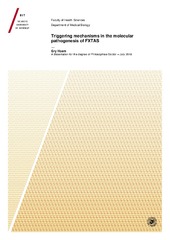| dc.contributor.advisor | Johansen, Terje | |
| dc.contributor.author | Hoem, Gry | |
| dc.date.accessioned | 2018-10-22T11:58:04Z | |
| dc.date.available | 2018-10-22T11:58:04Z | |
| dc.date.issued | 2018-10-31 | |
| dc.description.abstract | This study focuses on the triggering mechanisms leading to development of the neurodegenerative disorder Fragile X-associated tremor/ataxia syndrome (FXTAS). FXTAS affects carriers of a “premutation” in the Fragile X Mental Retardation 1 (FMR1) gene on the X chromosome. A premutation in this context, means the presence of 55-200 CGG repeats in the 5’untranslated region of the gene. Unaffected individuals in the normal population generally have < 45 CGG repeats. The long CGG repeat tract results in expanded mRNA which forms stable hairpin structures. In addition, premutation carriers have 2-8 fold elevated levels of this expanded FMR1 mRNA. The presence of the CGG-containing mRNA in intranuclear inclusions found in brain tissue from FXTAS patients, has led to the hypothesis that the expanded mRNA itself triggers development of FXTAS.
Both the number of CGGs in each mRNA molecule and the concentration of this mRNA are increased in FXTAS patients. It was not known which factor lead to downstream adverse effects. In the first part of our study, we therefore established a novel cellular model system for FXTAS, in which we could vary the mRNA levels for a range of CGG repeat sizes. Using cell death and changes in morphology as outcome measurements, we found toxicity only upon expression of > 62 CGG repeats, even when mRNA concentrations were 100-fold above endogenous levels. We conclude that there is a threshold for CGG repeat number, below which no cellular dysregulation is observed.
Later publications in the field have revealed that repeat-associated non-AUG (RAN) translation across the expanded CGG repeat tract causes formation of a toxic protein named FMRpolyG. However, whether FMRpolyG’s negative effects on cellular homeostasis depended on the presence of the CGG mRNA hairpin, was uncertain. In the second part of this study we used a cell-based model allowing expression of the FMRpolyG protein, without the CGG mRNA hairpin. We found that FMRpolyG, in the absence of a CGG repeat hairpin, causes aggregate formation, reduced viability and morphological abnormalities in cells. Our results indicate that FMRpolyG itself may trigger development of FXTAS. Future studies looking at endogenous FMRpolyG expression, and its levels in FXTAS patients versus unaffected controls, are needed to determine the exact role of this protein in disease development. | en_US |
| dc.description.doctoraltype | ph.d. | en_US |
| dc.description.popularabstract | Fragile X-associated tremor/ataxia syndrome (FXTAS) is a neurodegenerative disorder. The patients develop tremor, gait problems and often signs of dementia. It affects individuals with a specific mutation in a gene on the X-chromosome. This mutation is especially problematic to brain cells. It causes the formation of two potentially toxic molecules, an RNA and a protein. But which one is the main troublemaker? And why are they toxic to cells?
In her work, Gry Hoem has, together with co-workers, looked at how the RNA can be toxic. By studying what goes on inside cells that express different versions of this RNA, they found that a specific expansion of the RNA made it toxic.
The presence of this RNA in the cell, also leads to formation of an abnormal protein. In the second part of the study, they reveal that this protein itself is toxic to cells, even when the toxic RNA is absent.
These findings help identify the cause of FXTAS. That information is needed in order to develop treatments. | en_US |
| dc.description.sponsorship | UiT-Norges Arktiske Universitet
Norwegian Research Council | en_US |
| dc.identifier.uri | https://hdl.handle.net/10037/14006 | |
| dc.language.iso | eng | en_US |
| dc.publisher | UiT The Arctic University of Norway | en_US |
| dc.publisher | UiT Norges arktiske universitet | en_US |
| dc.relation.haspart | <p>Paper I: Hoem, G., Raske, C.R., Garcia-Arocena, D., Tassone, F., Sanchez, E., Ludwig, A.L., … Hagerman, P.J. (2011). CGG-repeat length threshold for FMR1 RNA
pathogenesis in a cellular model for FXTAS. <i>Human molecular genetics, 20</i>(11), 2161-2170. Full text not available in Munin due to publisher restrictions. Published version available at: <a href=https://doi.org/10.1093/hmg/ddr101>https://doi.org/10.1093/hmg/ddr101. </a><p>
<p>Paper II: Hoem, G., Larsen, K.B., Øvervatn, A., Lamark, T., Sjøttem, E. & Johansen, T. The
FMRpolyGlycine protein mediates aggregate formation and toxicity independent of the
CGG mRNA hairpin in a cellular model for FXTAS. (Manuscript). Full text not available in Munin. <p> | en_US |
| dc.rights.accessRights | openAccess | en_US |
| dc.rights.holder | Copyright 2018 The Author(s) | |
| dc.rights.uri | https://creativecommons.org/licenses/by-nc-sa/3.0 | en_US |
| dc.rights | Attribution-NonCommercial-ShareAlike 3.0 Unported (CC BY-NC-SA 3.0) | en_US |
| dc.subject | VDP::Medisinske Fag: 700::Basale medisinske, odontologiske og veterinærmedisinske fag: 710::Medisinsk biokjemi: 726 | en_US |
| dc.subject | VDP::Medical disciplines: 700::Basic medical, dental and veterinary science disciplines: 710::Medical biochemistry: 726 | en_US |
| dc.subject | VDP::Medisinske Fag: 700::Basale medisinske, odontologiske og veterinærmedisinske fag: 710::Medisinsk molekylærbiologi: 711 | en_US |
| dc.subject | VDP::Medical disciplines: 700::Basic medical, dental and veterinary science disciplines: 710::Medical molecular biology: 711 | en_US |
| dc.subject | VDP::Medisinske Fag: 700::Basale medisinske, odontologiske og veterinærmedisinske fag: 710::Medisinsk genetikk: 714 | en_US |
| dc.subject | VDP::Medical disciplines: 700::Basic medical, dental and veterinary science disciplines: 710::Medical genetics: 714 | en_US |
| dc.title | Triggering mechanisms in the molecular pathogenesis of FXTAS | en_US |
| dc.type | Doctoral thesis | en_US |
| dc.type | Doktorgradsavhandling | en_US |


 English
English norsk
norsk



